Cold, black metal might not be the first thing that comes to mind when you think of your ideal of cosiness. But for the Victorians, the cast-iron fixtures that flooded the market in the 19th century for fireplaces and heating appliances allowed not only for their homes to be kept heated, but for a display of their taste in ornamentation to take centre stage in the home.
The fireplace, its grate and surrounds made the perfect application for the large variation of shapes and detailing that could now be created in cast iron economically and at scale. This productive era is reflected in the Board of Trade design registers at The National Archives where manufacturers would register their designs for copyright protection. Between 1842 and 1883, the designs were classified according to material; Class 1 contains designs for manufacture in metal.
When manufacturers registered their designs, they were required to submit a representation of it, taking the form of an illustration, engraving or a photograph, and these were pasted into huge leather-bound volumes.
Browsing through these wonderfully chaotic records – some pages carry a few representations per page, some representations are upside down, or at different angles to the others – it’s barely possible to turn a page without coming across some new design for a register grate, set of fire dogs, fender, stove, or coal scuttle, with many designed to be made in cast iron.
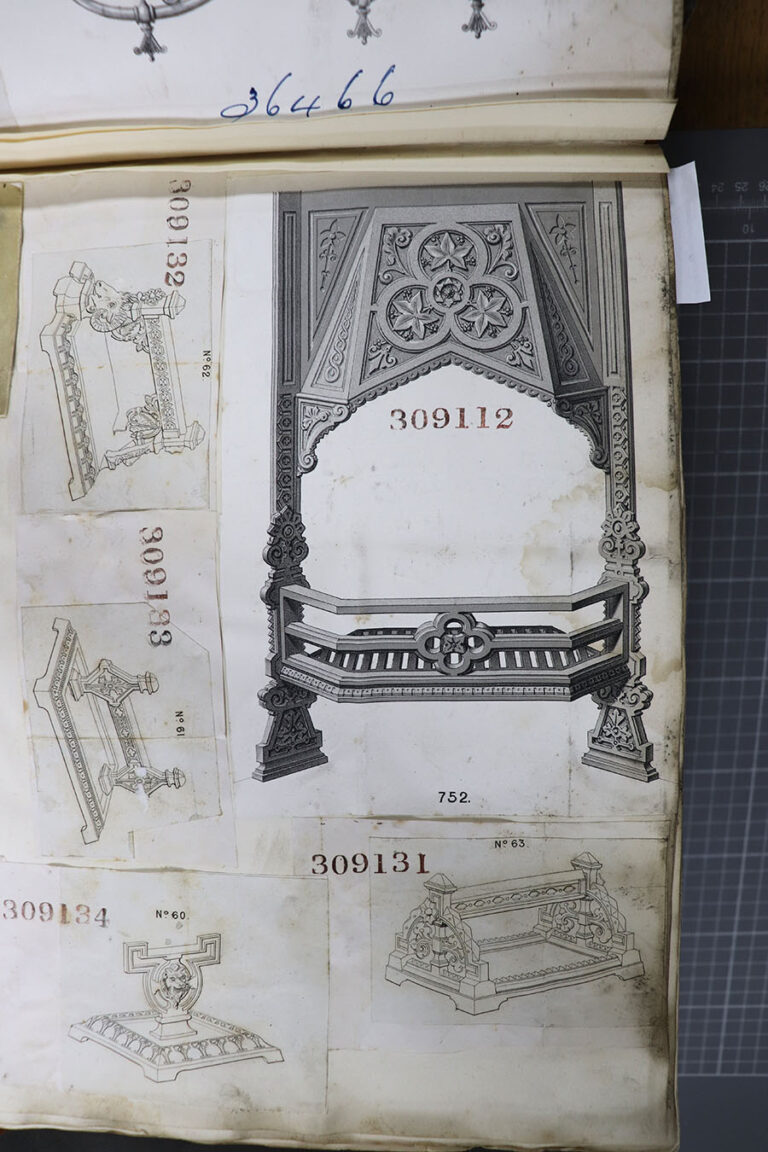
The applications of cast iron in functional and decorative objects increased rapidly in the 19th century and our records show the crossover between those two categories when it came to the fireplace and its surrounds. The sheer number of ornamental designs registered indicate they were desirable items.
An article in the American publication The Workshop from 1870 gives some insight into the contemporary view of the material’s malleable applications:
‘…cast-iron is largely employed not only for machinery and similar objects on which ornament is unessential and even superfluous, but also for many productions in which form and decoration are not only essential but are frequently the chief things in view, while the cheapness of the material and increasing needs of all kinds lead as [sic] to expect its much more extensive employment.’[ref]‘On the Decorative Treatment of Cast-Iron’, (1870) The Workshop, Vol. 3, https://archive.org/details/jstor-25617656/page/n1/mode/2up [accessed 3 December 2020][/ref]

A catalyst for the proliferation of cast-iron wares in domestic settings was the Great Exhibition of the Works of Industry of All Nations in 1851. The setting of the Exhibition, the Crystal Palace, was itself a monument to innovations in architectural applications of cast iron. Designed by Joseph Paxton, Head Gardener to the 6th Duke of Devonshire and the architect of the cutting-edge greenhouses on the Chatsworth Estate, the Crystal Palace was four times longer than St Paul’s Cathedral.
Over the five and a half months that the exhibition was open, more than six million people visited the Great Exhibition, taking in all that industry had to offer[ref]‘The Great Exhibition of 1851’, The Gazette, https://www.thegazette.co.uk/all-notices/content/100717 [accessed 3 December 2020][/ref]. Ironworks, foundries and ironmongers showcased their wares in eye-catching displays such as this one by William S Burton, a furnishing ironmonger with premises on Oxford Street in London.
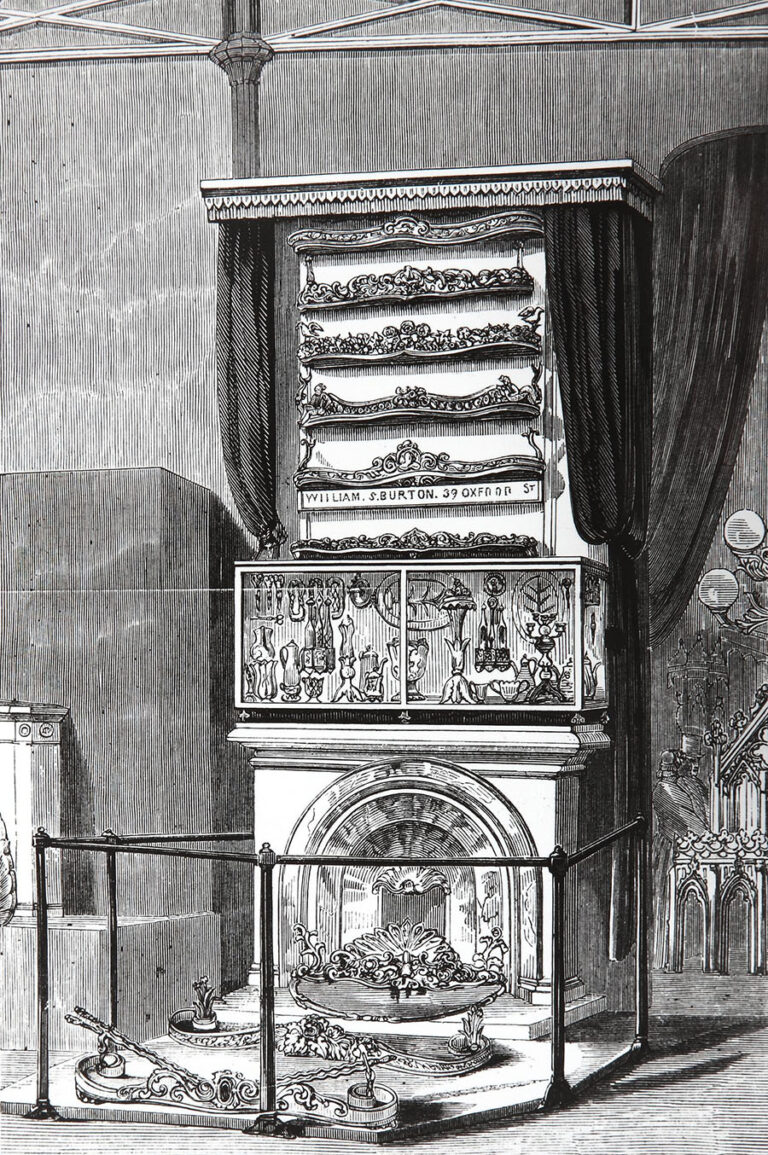
One of the great ironwork exhibits of 1851 were the Coalbrookdale Gates that stood at the Queen’s Entrance of the Crystal Palace. The ornamental gates, each cast in one piece, were made by The Coalbrookdale Company in Shropshire[ref]‘Coalbrookdale Gates’, The Royal Parks, https://www.royalparks.org.uk/parks/kensington-gardens/things-to-see-and-do/memorials-fountains-and-statues/coalbrookdale-gates [accessed 3 December 2020][/ref].
In 1709, The Coalbrookdale Company’s founder, Abraham Darby I, pioneered the substitution of coal for charcoal as the smelting fuel in the blast furnace, an innovation that essentially enabled ironworks to be relocated out of rural, wooded locations and closer to hubs of industry. 70 years later, Abraham Darby III engineered the world’s first cast-iron bridge over the River Severn in the Ironbridge Gorge[ref]‘Our Story’, Ironbridge Gorge Museums https://www.ironbridge.org.uk/our-story/the-iron-bridge/ [accessed 3 December 2020][/ref]. By 1851, The Coalbrookdale Company was said to be the world’s largest ironworks, with an output of over 2,000 tons a week[ref]Engineering Timelines http://www.engineering-timelines.com/scripts/engineeringItem.asp?id=344 [accessed 3 December 2020][/ref].

I’m drawn to the style of the representations for fireplace-related designs submitted by The Coalbrookdale Company, like this one for a register stove or hob grate with flat castings either side to hold kettles or to cook with. They have an artistic quality in comparison to others for similar objects. As I spent more time browsing through these records, I started to recognise the distinctive style of the Coalbrookdale designs even when their name hadn’t been added within the representation, like this design for a grate, registered in 1883.
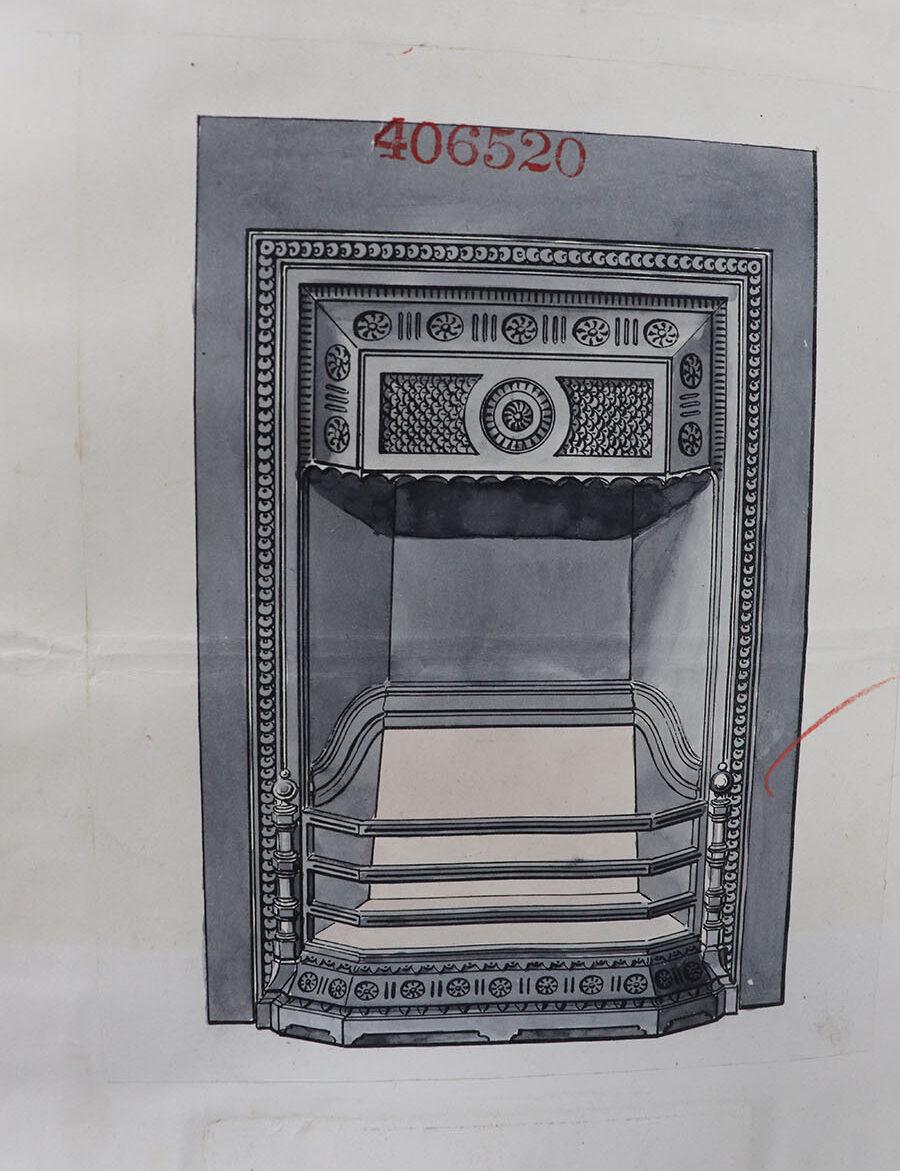
Interesting research by the Ironbridge Gorge Museum Trust into the production of trade catalogues of The Coalbrookdale Company and other ironworks might help provide some context into how the representations were being produced and by whom. For instance, in this representation we can see a tiny name printed at the base that could tell us more about the engraving company that created it.
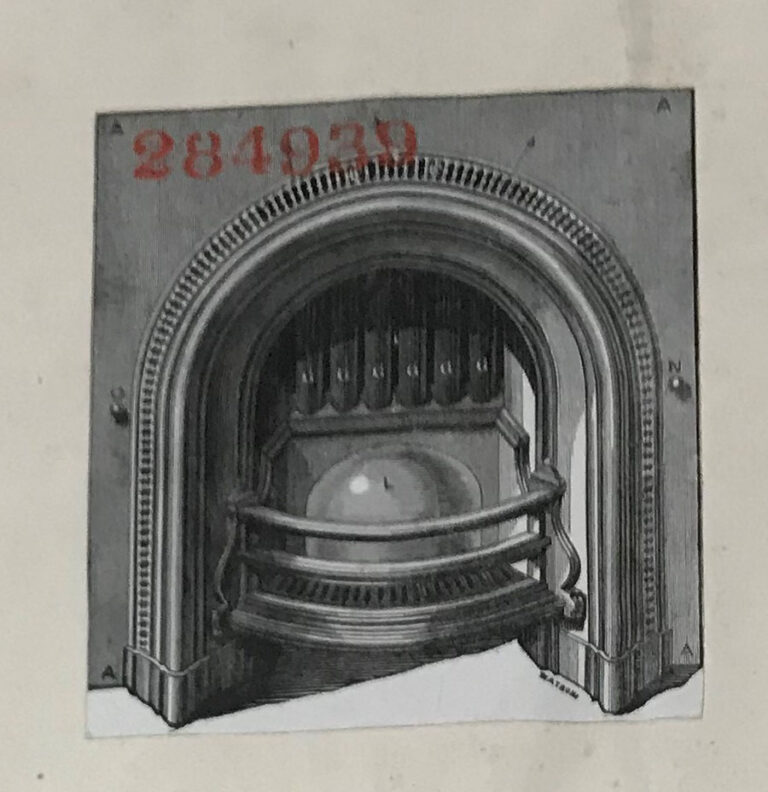
Of course it was far from just The Coalbrookdale Company registering their designs for cast-iron wares. Some of the other names of ironworks and foundries I came across in the BT registers representing the scale of its production across the United Kingdom and Ireland included Musgrave’s in Dublin, Smith and Wellstood in Glasgow, the Carron Company near to Falkirk, and A Ballantine & Sons who are still operating today as Ballantine Castings.
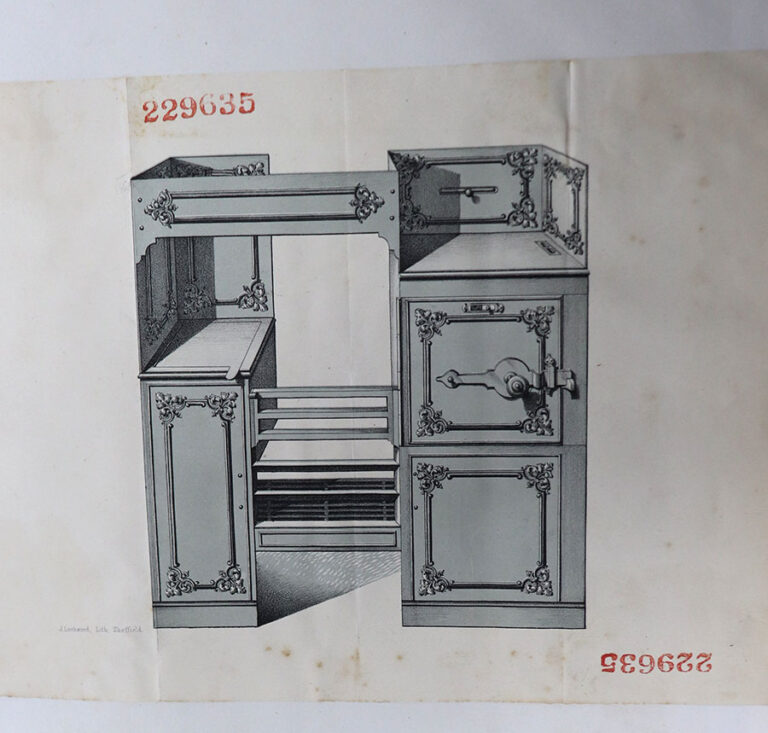
It wasn’t just fireplaces that were designed to act as decorative centrepieces either. Ornamental cast-ironwork can be seen in a range of heating appliances, from elaborate cooking ranges, to humble coal-burning stoves, to ornate gas heaters.
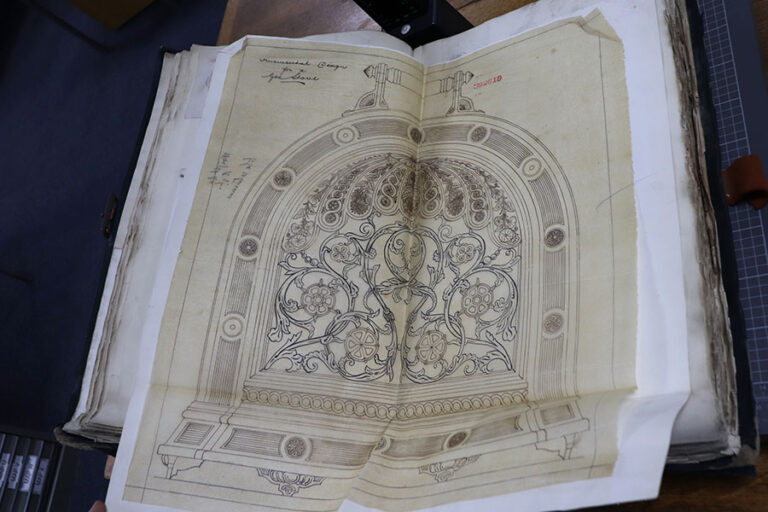
One of the challenges in working with these records is the uncertainty of whether the illustrated representations ever in fact made it into production, as that fact might tell us something about their commercial or technical success as a design. Occasionally, we catch a glimpse of one of the designs as an artefact in a museum collection, or represented in a trade catalogue or an advertisement.
However, the representations are beautiful records in their own right and shed light on the processes of design work and manufacturing of the Victorian era. With further contextual research, they can help us understand how objects from the past were designed, made and used.
How to search for design records
There are several approaches to looking for entries within the Board of Trade collection of designs, and this depends largely on what information you have already about the design or manufacturer and what information you are trying to find.
Your search is also dependent on the detail of our catalogue descriptions. Records after 1884 tend to be sparse in descriptive detail. If you don’t have a design number already, to find these records you’ll need to use the Patent Journal at the British Library which published lists of designs registered with their numbers.
This is just a quick overview of the process for a simple search for a representation and its corresponding information. For full instructions, our research guide goes into full detail.
All designs registered were allocated a design number. These numbers appear within our catalogue references after the numbers indicating the volume of the book for both representations and registrations.
For example, for the iron pole fire screen I mention in the document display, submitted by the Coalbrookdale Company in 1845, the reference for the representation is BT 43/3/28129 and for the entry in the register BT 44/1/28129. The numbers in bold indicate the design number assigned by the Designs Registry.
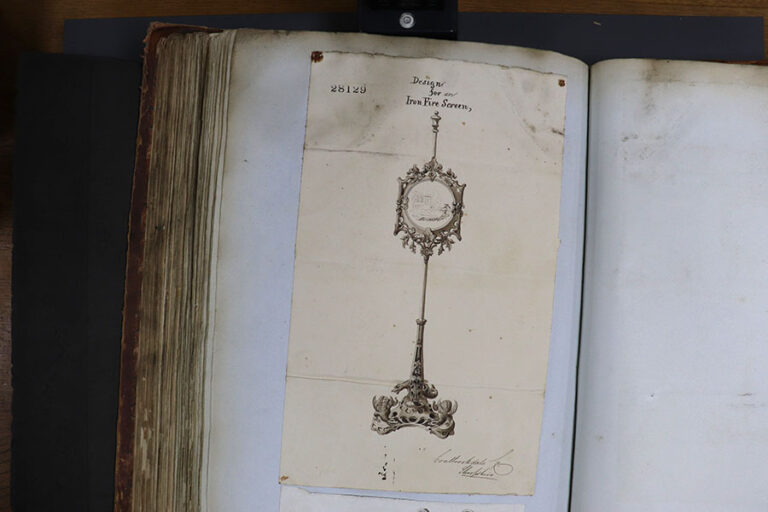
As you can see from the images, the design number was stamped onto the representations, so when you order a volume of representations, you just need to leaf through the pages to find the number you want to see.
Design numbers were typically stamped onto manufactured objects, so if you have the object in your possession you can look for a registration record with this – although watch out, because at a certain point numbers began to be re-used! If your design was registered between 1842 and 1883, you might have a diamond mark to work from.
You sometimes see the name of the manufacturer, title of the design and a date next to the representation – the fire screen has the manufacturer’s name and title but no date. Sometimes all three are missing. You might be able to find these details in the catalogue description on Discovery, but if not, you’ll need to order the corresponding register to find these out.

In this image of a page from the register BT 44/1, the entry for design number 28129 can be found right at the bottom and gives the date of registration as 16 June 1845, name and address of the manufacturer and name of the design being registered.
We posted videos of the process of looking for design representations and their corresponding registration on our Instagram page recently. For a visual guide to the process, I recommend checking them out.
Fascinating! Thank you.
Fascinating illustrations. And the history continues, cast iron parts for Aga and Rayburn cookers is still made in coalbrookdale.
This is very interesting.I remember the cast iron inserts in my grandfaters home-elegant and a gathering place. Thank you F.A.
Fascinating . Amazed at the artistry ..delicate and beautiful. Elizabeth Findlay
Very interesting will look more carefully when I see early cast iron fireplace….or for that matter reproduction ones
Of course most people could not afford such luxury .
I am 88 and remember visiting many houses in the 1930’s which still had these types of grates. It brought back many memories including toasting bread over a coal fire.
In my uncles farmhouse he had a large cast iron stove used to cook and
Heat his home. We had an outhouse and a spring house.. He was a dairy
Farmer and had 200 acres of land. It was not so long ago circa early 1960’s.
Farmers in NW Pennsylvania were self sustaining. Those days are gone.
I still have the house that my Grandpa bought in 1907. I think the Kitchen was the first part of the house that was there a long time before the main house was built on to it and included as the kitchen. In the kitchen we still have the bread oven in the corner of the inglenook where Grandad baked the bread he sold in the village. A settle now fills the inglenook where the fireplace was originally and where grandpa’s wood burning ovens used to be. On the right of the inglenook we still have the brick bread oven. It makes a great wine and beer storage place as it’s so cool.
In the living room we also still have the cast iron fireplace that still works well. I’ve tried to include photographs of both here but photographs won’t be accepted.
Brings back fond memories of hours and days I have spent at TNA Kew going through the Design Office ledgers!
I have now moved to Bristol so alas not so easy to pop into Kew.
Thanks so much for such a lovely and informative piece.
Any plans to digitise the ledgers?
As a chimney sweep in in Dundas, ON. Canada (about 1 hr from Niagra Falls), I still see homes that have cast iron coal grates. Some have all the parts in working order, a few have decorative tiles, but most have missing parts. The homes that do have these coal grates have been constructed before modern building codes, and to keep them in working order the owner needs to spent several thousand dollars, therefore most are removed completely or converted to natural gas and the coal grate is thrown in the garbage (dust bin).
Can remember a cast iron fireplace in our 1950 style council house in liverpool
I was very disappointed when my mother discarded the cast iron fireplace and oven so that she could have a modern tiled fireplace. It didn’t cook and wasn’t as beautiful in my eyes (who had known nothing else in my life). I’d love to have one now, the nearest thing is a wood burning stove which we installed a few years ago, I cook on it but it doesn’t have an oven.
I have such a fireplace in my Victorian terraced house. I enjoy sitting in front of a real fire on these cold winter evenings.
Oh! I’ve just bought a new house – as in recently built – that comes with a cast iron fire-place! It’s gorgeous.
We had small cast iron fire places in each bedroom and Brompton style bigger ones in the living room in our Victorian house in Liverpool…I user to hide things from my siblings under the grate! We live in Melbourne now. Amidst all the Aussie styles of homes there are several Victorian suburbs with the colonial style houses built in the 1880s, some of which also have these wonderful original fire places. They can seem a little out of place when the temperature hits mid 30s !
We bought an 1851 built house where the cast iron grates had been removed and the chimney breasts blocked up. I researched the correct period cast iron fireplaces and bought replacements from fireplace shops in the Old Kent Road before these became expensive. I replaced all the fireplaces and marble chimneypieces to bring the house back to its correct appearance. I also restored all the sash windows including their glass with correct cylinder glass. It was a labour of love but It restored authenticity to the house. Early grates are more elaborate with naturalistic decoration in cast iron. There is a hierarchy in size and quality with small simple grates in upstairs or servants rooms and these have simple plaster or timber chimneypieces.
Glad to know that these things are becoming gradually more available. They just closed the Nottingham library that had wonderful archives of their own into local designs and manufacturers, maps and period documents. My wife and I bought an 1853 and beyond house in an old Lace manufacturing area to the north of the city centre. South facing. Found one original fireplace. All others removed. Kitchen downstairs (in the cellar) quite clearly had had a range but either buried in the garden or sold for scrap no sign of it. Would be interested in the possibilities of getting a temporary one to fill the gap as gas and energy all getting more and more expensive. The possibility of heating water is very exciting. Very practiced at making nearly smokeless fires using vortices and correct fuel in correct combinations. If any one has any ideas how to make these stoves more efficient but without losing their beauty then please write to me at hrgallie@aol.com
Hello. I have a cast iron fireplace and am having no luck finding anything about the history of it or where it came from. Do you know anyone I could share photos with who may be able to help? There are numbers on the back of the side panels and the mantle. Any help with this would be greatly appreciated. Thank you for your time :). Take care.